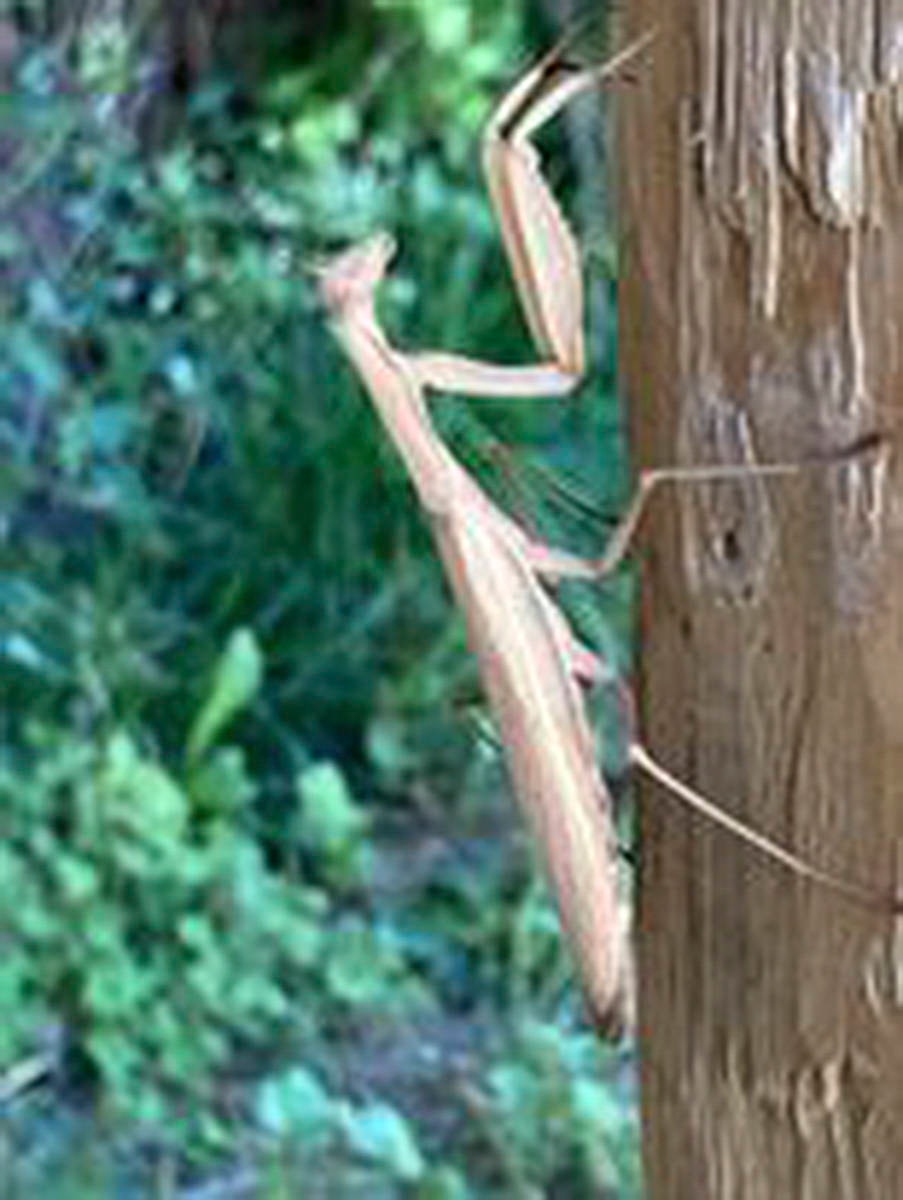With six long, slender legs, protuding widespread eyes on a triangular head, as well as a neck that can swivel 180 degrees, an unusal creature has been making its presence known in the Shuswap recently.
Although its name is familiar to many people, the praying mantis is not a commonly seen resident and can be tricky to spot.
These insects have been noticed recently in Salmon Arm, Enderby and around the Shuswap. According to social media and in-person accounts, they have landed on humans or have just been in spots where they stand out.
One in Silver Creek landed on Alice Hucul’s hand and she shook it off, not really seeing it. Then it landed on a post, where she got a good look and was able to take a photo. It was brown and she wasn’t sure if it was a ‘stick bug’ that sits camouflaged in its habitat or a praying mantis.
Chélie Elsom-Pharand also spotted one of the brown variety, this one on a hose at gas pumps in Enderby. She pumped her gas, expecting it to fly away, but it didn’t.
“I couldn’t leave the poor thing at the gas pump – I put out my hand and it walked right onto it and I carried it across the street to a bush so it could be safe,” she said. She added that she’s an avid environmentalist; “I believe we need to do everything we can to look out for the little critters.”
Read more: VIDEO: Praying mantis fights black widow in epic West Kelowna battle
Read more: ‘Tis the summer of the earwig, say some Salmon Arm residents
Read more: Agriculture ministry looks for special stink bugs in Salmon Arm and region
Susanna Acheampong, an entomologist with the B.C. Ministry of Agriculture, Food and Fisheries, explained that although praying mantids are not common in the area, they mate and lay eggs in late summer and that may be why people are seeing them now.
“They are usually camouflaged and may go unnoticed,” Acheampong said.
(According to Internet definitions, only some mantids belong to the genus mantis, so the term ‘mantid’ refers to the whole group)
They get their ‘praying’ description from the way their front legs are poised when they’re on the attack. They look similar to human hands praying and are those ‘hands’ are held below their head.
Acheampong said the most common species in the region is the European mantis, which comes in brown or green. She said it was introduced to the Thompson-Okanagan in the late 1930s in a failed attempt to control grasshoppers. It has been around in very low numbers since.
She said she has had only had a few reports of them since 2008, mainly from Osoyoos and Vernon. She did see one flying in an alfalfa field in Enderby in 2019.
They feed mainly on other insects and will eat whatever they catch – grasshoppers, beetles, crickets, caterpillars, flies and other small insects. According to accounts online, this wide appetite can create problems because while they might devour grasshoppers, they’ll also eat bees or other insects considered favourable for crops.
When they hunt they sit camouflaged and then ambush their prey with great speed. Their front legs have little spikes which help in restraining. A 2017 study of about a dozen countries found praying mantises will even catch and eat small birds.
One of the praying mantis’ unusual characteristics is that it sometimes eats potential mates, or devours them after mating, which can be seen on YouTube videos.
However, they are not dangerous to people or pets and do not bite, sting or produce venom, Acheampong said.
Maybe because of its strange, movie-alien looks or its unique characteristics, the praying mantis and its presence is portrayed in online accounts as symbolic – a symbol, in most cases, of good luck.
martha.wickett@saobserver.net
Like us on Facebook and follow us on Twitter and subscribe to our daily newsletter.
